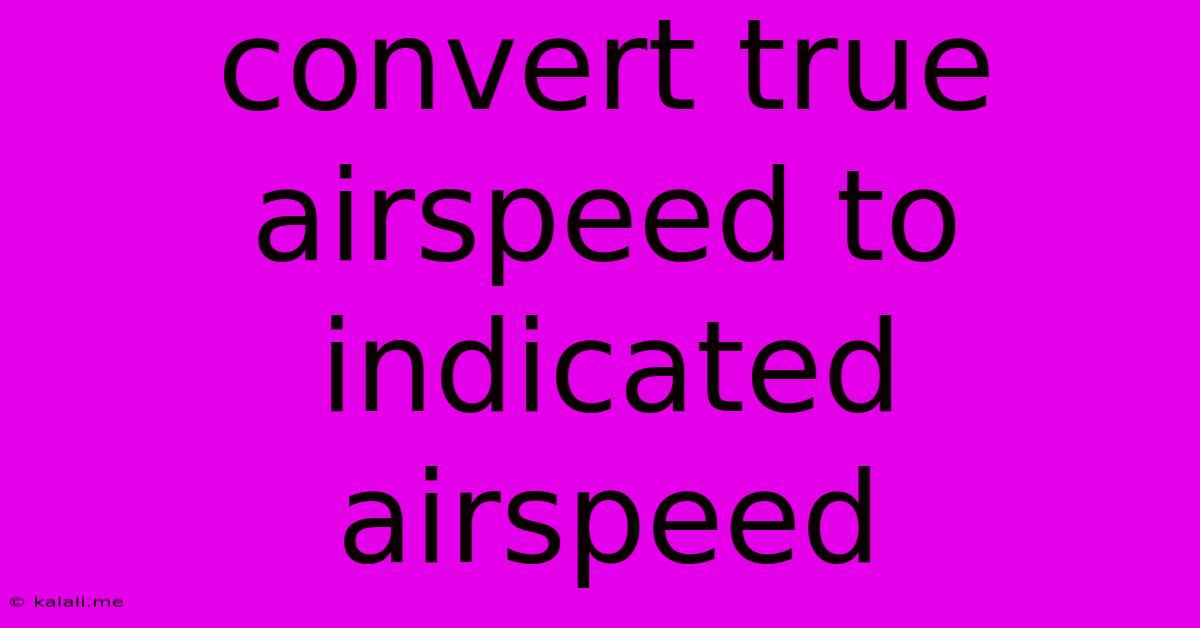Convert True Airspeed To Indicated Airspeed
Kalali
May 29, 2025 · 3 min read

Table of Contents
Converting True Airspeed to Indicated Airspeed: A Pilot's Guide
Meta Description: Learn how to accurately convert true airspeed (TAS) to indicated airspeed (IAS) using a simple, step-by-step guide. Understand the factors influencing airspeed and improve your flight calculations.
Pilots need to understand the difference between true airspeed (TAS) and indicated airspeed (IAS) for accurate flight planning and safe operation. While IAS is what your airspeed indicator shows, TAS represents the aircraft's actual speed relative to the surrounding air mass. This article will guide you through the process of converting TAS to IAS, considering the key factors involved.
Understanding Airspeed: IAS, CAS, and TAS
Before diving into the conversion, let's clarify the different types of airspeed:
-
Indicated Airspeed (IAS): The speed shown directly on your aircraft's airspeed indicator. This reading is uncorrected for instrument and position errors.
-
Calibrated Airspeed (CAS): IAS corrected for instrument and position errors. This is a more accurate representation of the airspeed.
-
Equivalent Airspeed (EAS): CAS corrected for compressibility effects. At higher altitudes and speeds, air becomes compressible, affecting the airspeed indicator's accuracy.
-
True Airspeed (TAS): EAS corrected for air density. Air density varies with altitude and temperature, directly impacting the aircraft's performance. TAS represents the aircraft's actual speed relative to the air mass.
Factors Affecting the Conversion: Density Altitude and Temperature
The primary factors influencing the conversion from TAS to IAS are density altitude and temperature. Density altitude is a crucial factor because it reflects the air's density at a given altitude, considering both pressure and temperature. Colder temperatures lead to higher density, while warmer temperatures result in lower density.
Higher density altitude means the air is less dense, resulting in a higher TAS for the same IAS. Conversely, lower density altitude means denser air and a lower TAS for the same IAS.
Converting True Airspeed (TAS) to Indicated Airspeed (IAS): A Step-by-Step Approach
Precise conversion requires specialized flight calculators or aviation software. However, a simplified approach, assuming standard atmospheric conditions, can provide a reasonable estimation. This involves using the following considerations:
-
Obtain your True Airspeed (TAS): This is usually calculated using flight planning software or determined from your navigation system.
-
Determine Density Altitude: Use a density altitude calculator or consult a flight planning tool to find the density altitude based on your current altitude, temperature, and atmospheric pressure.
-
Consider Temperature Deviation: The temperature deviation from standard temperature at your altitude significantly impacts air density. A colder-than-standard temperature will increase the density, making the TAS lower for the same IAS. A warmer-than-standard temperature decreases density.
-
Use a Conversion Chart or Formula (Approximation): While precise calculations are complex and require specialized tools, a rough estimation can be made using a simplified conversion chart or an approximate formula. Keep in mind that the accuracy of this method depends heavily on the closeness of conditions to standard atmosphere.
-
Apply Corrections (Advanced): For higher accuracy, especially in non-standard atmospheric conditions, you'll need to incorporate additional corrections for compressibility effects using flight computers or aviation software.
Importance of Accurate Airspeed Conversion
Accurate conversion between TAS and IAS is vital for several reasons:
- Fuel Efficiency: Precise airspeed management contributes to optimal fuel consumption.
- Navigation: Accurate airspeed is essential for precise navigation and arrival calculations.
- Performance: Understanding the relationship between TAS and IAS allows pilots to better manage aircraft performance at various altitudes and temperatures.
- Safety: Accurate airspeed knowledge is crucial for maintaining safe flight operations, particularly during takeoff, landing, and maneuvering.
Conclusion:
Converting TAS to IAS is a critical skill for any pilot. While simplified estimations can be helpful, accurate conversions typically require specialized tools and a comprehensive understanding of atmospheric conditions. Remember to prioritize safety and always consult your aircraft's pilot operating handbook for specific procedures and limitations.
Latest Posts
Latest Posts
-
How Do You Find Your Whatsapp Number
May 30, 2025
-
How Do You Make Super Powers
May 30, 2025
-
Will Usb Mini Reciever Work On Regular Usb Ports
May 30, 2025
-
What Has A Head But No Neck
May 30, 2025
-
How Long Does It Take For Weed Killer To Dry
May 30, 2025
Related Post
Thank you for visiting our website which covers about Convert True Airspeed To Indicated Airspeed . We hope the information provided has been useful to you. Feel free to contact us if you have any questions or need further assistance. See you next time and don't miss to bookmark.